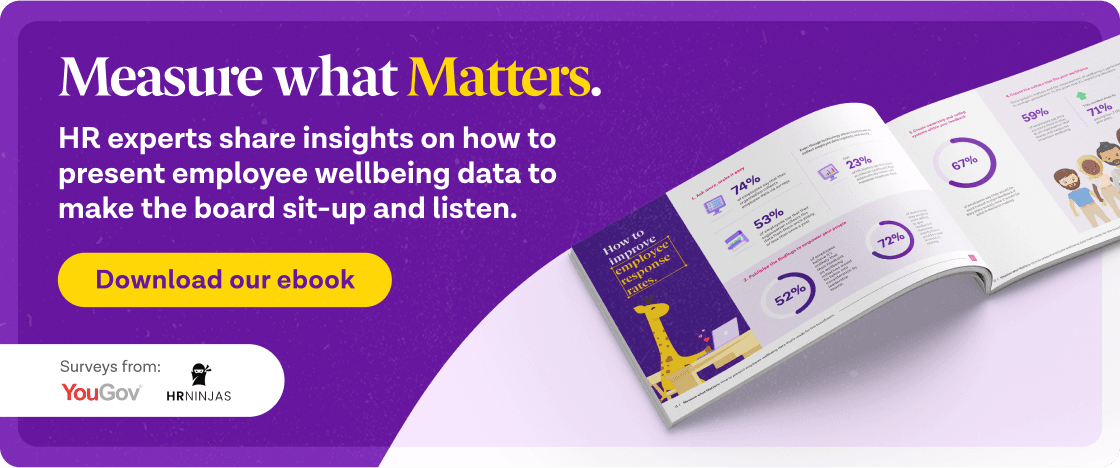
Measuring employee wellbeing: Are you asking your people?
A new survey explores the subject of measuring employee wellbeing – and highlights a mistake many organisations are making
Sammy Rubin | Founder & CEO of YuLife - 7 September 2023
We all know it. Healthy people perform better, achieve better results, and work better together. But we also live and work in volatile times with political, environmental and economic complexity – creating an environment of healthy, happy employees is tough.
But whatever your employees’ emotional status, your journey starts at the same place: measuring employee wellbeing. The latest YuLife survey shows the potential of data to create a window into employee sentiment that tells a powerful story.
“It seems the key isn’t gauging employee sentiment – that is happening in many workplaces already – but if [measuring employee sentiment] happened more often, it has more powerful potential to inform the business right up to the boardroom,” says Lauren Berkemeyer, YuLife CMO.
“Feeling that your boss is interested in you as a person, that you belong, that your role has value and meaning in the whole picture, are factors primary to our employees’ engagement by extension the success of the business.”
Measuring more regularly
Measurement is happening within businesses already, with 74% of workers saying that their organisation collects employee data via surveys.
But the problem is the frequency and mode of collection:
- More than half (53%) of employees say that their organisation only collects this data from them only once yearly, or less than once a year.
- And despite the rise of wearable technology allows people to collect data automatically (such as step counts), regularly and easily (through employee apps). Only 22.7% of HR leaders say they have an internal dashboard that automatically tracks and measures employee data.
Employees want greater transparency around their data
The other issue is that once businesses have the data, they aren’t always sharing the actions that fall out of it.
- 52% of workers believe it’s unlikely that their feedback on wellbeing initiatives would be taken into consideration by leadership teams.
- And in not providing this transparency, organisations are losing an opportunity to engage their teams, with 72% of workers saying they would be more willing to give feedback if they knew exactly how it would be used in decision-making.
But part of the value of asking your employees about their wellbeing comes from the act itself: showing that you care. And this is particularly important for younger workers: 59% of workers say they would be more likely to stay at an organisation that tracks and measures employee wellbeing, compared to one that didn't. This number rises to 71% among 18-24 year olds.
So if you’re measuring employee wellbeing but want to do it better, where do you start?
1) Measure more often
More than a third of employees (34.2%) say that their organisation doesn’t collect or rarely collects data on employee wellbeing, and does not measure it. Of the remainder, 20.3% said they collected data yearly, 12.4% every six months, 20.7% quarterly, 18% monthly and just 4.4% weekly.
2) Consider how you’re collecting data
As well as how often data is collected, the employee survey also probed how it was collected. The most popular answer by far was employee/pulse surveys (72.5%), followed by 1:1 meetings (33.7%), and focus groups (19.2%). Only 8.6% chose the option: "We partner with third parties like apps or research institutes that help us measure and track employee wellness metrics."
3) Measure qualitative with quantitative data
The qualitative data produced from methods such as one-to-ones and focus groups is, of course, vital. But without quantitative data to back it up, it can mean HR professionals struggle to make their case for employee wellbeing internally.
HR influencer Lucy Adams, of Disruptive PR, also believes that central to the relationship between data, and the employee experience, is this transparency and employee empowerment. “Treat them as adults, as consumers, as real human beings to create an environment where they feel good. Most organisations are still incredibly parental. We’re geared up to care but we also try to protect the organisation from the badly behaving employees. Instead of being the nursemaid, we can treat people as grown-ups, empower them to behave as grown-ups – do that, and watch all KPIs from engagement go in the right direction.”
Want to read more on how to create a data-driven case for employee wellbeing? Download our latest ebook.
Share this article
Sammy Rubin | Founder & CEO of YuLife
Sammy combines his extensive experience in financial services with a deep commitment to holistic wellness. After launching and rapidly growing a successful insurance business with his late father, Sammy took a transformative sabbatical that inspired him to create YuLife in 2016. His vision is to enhance lives through technology that supports physical, mental, social, and financial wellbeing.










